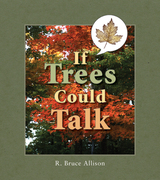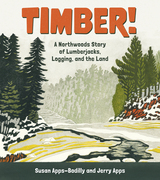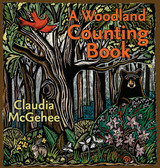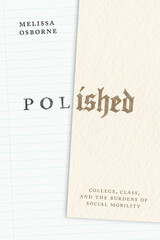3 books about Trees & Forests

If Trees Could Talk
Stories About Wisconsin Trees
R. Bruce Allison
Wisconsin Historical Society Press, 2009
Inside the pages of If Trees Could Talk, Allison gives readers aged 7 to 12 fascinating stories that introduce them to noteworthy trees, both past and present, across Wisconsin. From Kenosha's buried forest on the shores of Lake Michigan to the Wyalusing maple that saw the last of the passenger pigeons; from Aldo Leopold's "good oak" to the disappeared elms of State Street in Madison, these stories open up a fascinating ecological and social history of Wisconsin to young readers. Other stories showcase the state's history: readers will encounter Chief Black Hawk hiding in a hickory, Civil War soldiers enlisting for battle under "sign-up" trees, and trees used to hang criminals without a trial. They will also learn of large and unusual trees like the Columbus Cottonwood, which was over 26 feet around or, in the words of the author, so large that "it would take you and eight of your friends with your arms outstretched to reach all the way around it!"
Told in a compelling narrative style and supplemented with historic photographs and illustrations, these stories instill a sense of place and understanding of the rich heritage of our trees and forests. The book also carries an environmental message encouraging children to appreciate and manage natural resources wisely and respectfully. The highly accessible format includes a map of historic trees locations, a glossary of tree terms, a tree identification chart, and a list of suggested books and websites for further reading.
[more]

Timber!
A Northwoods Story of Lumberjacks, Logging, and the Land
Susan Apps-Bodilly
Wisconsin Historical Society Press, 2024
A heavily illustrated children’s history of the logging boom in the 19th century and the conservation efforts that followed.
How did the logging boom begin? What was it like to work in the woods? What happened to the land after the trees were cut down? The latest book for young readers from father-daughter duo Jerry Apps and Susan Apps-Bodilly explores the origin story of Wisconsin’s logging boom, the devastation it caused to the land, and the extraordinary efforts to restore the cutover land and log sustainably.
Timber! helps young readers examine a complex and pivotal chapter in our state and nation’s history, covering a wide range of topics, including:
• how Native people used, shared, and relied on natural resources for thousands of years
• the forced removal of Native people from forested lands
• how the lumber industry made possible the westward expansion of the United States
• what it was like to work in a logging camp, on a log drive, and inside a sawmill
• the roles on a logging team, from sawyer to cook
• the destructive legacy of early logging practices and early efforts to restore the land
• the emergence of sustainable forestry practices
This comprehensive yet easy-to-read history includes letters, postcards, and other primary sources paired with discussion questions designed to engage young readers’ creativity and critical-thinking skills. Timber! also features more than 100 images, a glossary, suggested activities, and an extensive list of related resources, including books, websites, teaching materials, museums, and outdoor places to visit. Timber! will inspire readers of all ages to explore, protect, and learn about trees and forests in their own communities.
How did the logging boom begin? What was it like to work in the woods? What happened to the land after the trees were cut down? The latest book for young readers from father-daughter duo Jerry Apps and Susan Apps-Bodilly explores the origin story of Wisconsin’s logging boom, the devastation it caused to the land, and the extraordinary efforts to restore the cutover land and log sustainably.
Timber! helps young readers examine a complex and pivotal chapter in our state and nation’s history, covering a wide range of topics, including:
• how Native people used, shared, and relied on natural resources for thousands of years
• the forced removal of Native people from forested lands
• how the lumber industry made possible the westward expansion of the United States
• what it was like to work in a logging camp, on a log drive, and inside a sawmill
• the roles on a logging team, from sawyer to cook
• the destructive legacy of early logging practices and early efforts to restore the land
• the emergence of sustainable forestry practices
This comprehensive yet easy-to-read history includes letters, postcards, and other primary sources paired with discussion questions designed to engage young readers’ creativity and critical-thinking skills. Timber! also features more than 100 images, a glossary, suggested activities, and an extensive list of related resources, including books, websites, teaching materials, museums, and outdoor places to visit. Timber! will inspire readers of all ages to explore, protect, and learn about trees and forests in their own communities.
[more]

A Woodland Counting Book
Claudia McGehee
University of Iowa Press, 2006
Towering oak and hickory woodlands once fringed the tallgrass prairie of the Midwest. In a wondrous mixture of plant and animal life, big mammals like black bears and cougars thrived alongside gray foxes and ovenbirds. But as more people arrived, the woodlands, like the tallgrass prairie, were cleared with amazing speed. Now only small portions of this special habitat remain, and many of its animals and plants are endangered or extinct. Despite the great loss, many people are working to restore and enlarge what remains so that woodlands can continue to support a rich wildlife community. And so we can all enjoy a walk in the woods. A Woodland Counting Book helps children learn about the woodland family. From one splendid white oak to fifty busy carpenter ants, illustrator Claudia McGehee counts the wonders of the woodlands in this beautifully illustrated companion to her previous children’s book, A Tallgrass Prairie Alphabet. As she follows spring to summer to fall to winter, returning at the book’s end to springtime in “one woodland community,” McGehee introduces more than twenty species of plants and animals. From the white oaks that tower overhead to shelter the woodland citizens to the delicate showy lady’s-slipper orchid and from the barred owls with distinctive hoots and calls to tiny evening bats which roost in hollow trees, we meet a wild world of woodland life. We find luna moths and serviceberries, shagbark hickories, blue spotted salamanders, wild turkeys, red squirrels, orchard orioles, and a host of other familiar and not-so-familiar plants and animals. A section of woodland notes gives common and scientific names of and interesting information about all featured species. These vibrantly colored scratchboard illustrations reveal the beauty of our woodland communities, guiding nature lovers and children of all ages through a much-loved landscape.
[more]
READERS
Browse our collection.
PUBLISHERS
See BiblioVault's publisher services.
STUDENT SERVICES
Files for college accessibility offices.
UChicago Accessibility Resources
home | accessibility | search | about | contact us
BiblioVault ® 2001 - 2024
The University of Chicago Press









